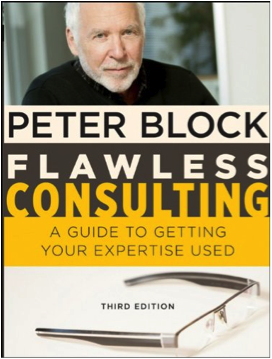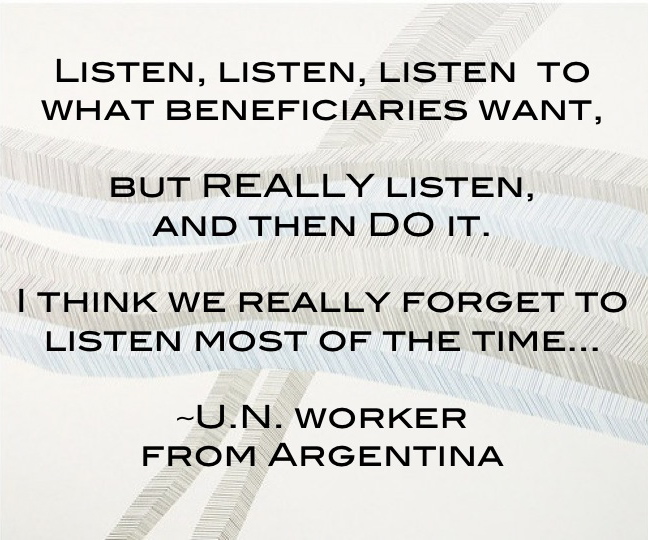This is a guest post by Joe Shaffner, the second in a series of seven blog posts from my International Development Communications students at Georgetown University’s Public Relations and Corporate Communications Masters Program.
***
Just as important as it is to move forward on a community project, it is equally, if not more important, to know when to stop and listen. I would not confine this strategy to international development. On the contrary, I would stress the importance of this in any cross-cultural communication scenario. The need to listen to the needs of the community is ubiquitous.
 Some people may limit the application of Peter Block’s book, entitled Flawless Consulting: A Guide to Getting Your Expertise Used, to business consulting in so-called “developed” countries. But I would argue that Block’s concepts could be applied appropriately to most any working relationship in which community members are treated more like clients than “beneficiaries”. After all, even though a donor agency may be paying for the services provided, the community members are those who will experience the change and deserve that respect.
Some people may limit the application of Peter Block’s book, entitled Flawless Consulting: A Guide to Getting Your Expertise Used, to business consulting in so-called “developed” countries. But I would argue that Block’s concepts could be applied appropriately to most any working relationship in which community members are treated more like clients than “beneficiaries”. After all, even though a donor agency may be paying for the services provided, the community members are those who will experience the change and deserve that respect.
In his book, Block discusses the varying forms of resistance to change a client may exhibit as a consultant advises on the client’s processes and activities. Block focuses, to a large extent, on why clients may resist changes that will benefit them. However, Block goes on to say that “Sometimes client objections are not resistance. The client just doesn’t want to do the project.”
This is an important point to keep in mind in international development, as well. When development organizations face active or passive resistance, it may well be the case that the community being served does not want assistance, or at least assistance without initial in-depth consultation. If there is little or no discussion with the community before work begins – and by that I mean sitting down at length with community members, listening, and learning about key priorities – the project risks no buy-in by the community and a waste of everyone’s time and money. Of course this doesn’t happen because of funding deadlines and donor pressures, and this is not always an easy process for communities themselves.
Through more in-depth consultation, there are often moments that arise when community members disagree with each other, and it is moments like these that should give development professionals pause. In these discussions, differing opinions need to play themselves out. It is incumbent on development organizations to stop and listen for internal resolutions rather than push agendas. This is getting to the root cause of what Block would refer to as “presenting problems”. Block asserts, “The presenting problem and the real (or underlying) problem are different.” Personally, I would not apply the term “problem” to every scenario in international development. However, I do believe that discussions take time to get to the true and shared needs of a community.
 Another point of consideration is governmental buy-in. If a community project lacks support by the government, there may be little room for growth. Take, for example, an experience I had while in the Peace Corps. The community in which I was stationed wanted to establish a gas-generated electrical grid similar to those in neighboring communities. Prior to my arrival, the government had provided electrical cables and a generator. However, the cables had lain on the ground in a pile for a couple of years. This community was not a priority for the government. So, the community members decided to hoist the cables on their own and attach them to the generator.
Another point of consideration is governmental buy-in. If a community project lacks support by the government, there may be little room for growth. Take, for example, an experience I had while in the Peace Corps. The community in which I was stationed wanted to establish a gas-generated electrical grid similar to those in neighboring communities. Prior to my arrival, the government had provided electrical cables and a generator. However, the cables had lain on the ground in a pile for a couple of years. This community was not a priority for the government. So, the community members decided to hoist the cables on their own and attach them to the generator.
Unfortunately, the communities in the region relied on, and continue to rely on, the government for fuel. So, even though the grid was established, the community has regularly gone without electricity for months and months. Meanwhile, coastal regions receive electricity twenty-four hours a day from a hydroelectric dam that was constructed in the area where the community members had originally resided.
In this case, whether government buy-in comes in the form of connecting these communities to the dam-generated electricity or providing a regular fuel supply, this is one point where getting to the root issue (or as Block calls it, the “real…problem”) is key. Though the will of the community showed up in force, government support was essential.
Whether at the local, regional, or national level, there are multiple considerations and key players that are necessary for a project to be successful. Buy-in by all of these players takes time to establish. Development organizations and donor agencies should first recognize the importance of stopping and listening to those they serve, as well as the decision-makers, before taking the next steps. Otherwise, they run the risk of missing the real issues.
***
 Joe Shaffner has over 12 years of experience in communications, marketing, partnership development, management, community engagement, and capacity building. Half of that has been in the international development arena – where he volunteered with the Peace Corps, managed the Marketing Department of an architectural and engineering international development consulting firm, and collaborated with UNICEF and the Pan American Health Organization. Through these experiences, he has worked with people at many levels – from local communities, to non-profit and for-profit organizations, to local government officials, to foundations. Through creative ideation, he continues to look for ways to give back to the global community as well as his local community.
Joe Shaffner has over 12 years of experience in communications, marketing, partnership development, management, community engagement, and capacity building. Half of that has been in the international development arena – where he volunteered with the Peace Corps, managed the Marketing Department of an architectural and engineering international development consulting firm, and collaborated with UNICEF and the Pan American Health Organization. Through these experiences, he has worked with people at many levels – from local communities, to non-profit and for-profit organizations, to local government officials, to foundations. Through creative ideation, he continues to look for ways to give back to the global community as well as his local community.
Joe has a B.A. in psychology from the University of North Carolina at Chapel Hill and just last week received a master’s degree in Public Relations & Corporate Communications (social impact emphasis) from Georgetown University’s School of Continuing Studies.
***
Related Posts
Not your usual listening exercise: 6000 people’s perception of aid delivery
Time to Listen? Time to address our organizational barriers
Spotting community ownership: A reminder
Community Resilience: An Untapped Resource for Sustainable Development?
